Automated Solutions and Robotics Debut at Automate 2023

Images courtesy of Big Joe, Dobot, IPLUSMOBOT, SCHEENBERGER and Gather AI
KUKA Shows off Camera, Mobility and Hygienic Pick-and-Place Tech
Kuka brought to the event its AGILUS, DELTA HM and SCARA robots working with a KMR iiwa mobile automation platform in a pick and place/bin picking cell. Designed to simulate a real production environment and automation solutions for each step— moving material from receiving and sorting to packing and distribution—the cell included KUKA’s new KR 3 DELTA Hygienic robot, KR 6 SCARA and KR 6 AGILUS robots, a KMR iiwa autonomous mobile platform and advanced vision software, KUKA.VisionTech.
For vision capability, the cell used a 3D camera and SICK vision system for recognizing randomly situated materials. Once an object has been identified and selected, the trajectory planning system governs robot movements and provides the orientation required to remove the object without colliding against the walls of a container or other nearby elements.
As the automated mobility aspect of the demonstration cell, KUKA’S KMR iiwa combines the sensitive KUKA LBR iiwa lightweight robot with a mobile, flexible platform. Designed to move omnidirectionally and execute 360° rotations, the KMR iiwa is autonomous, reacting immediately if a person or object is in the way and achieves a positioning accuracy of up to +/- 5 mm. Equipped with a KUKA AIVI control system that uses artificial intelligence to direct automated guided transport vehicles, the KMR iiwa is designed to ensure optimum material flow to the production line. The KMR iiwa is location-independent and highly flexible, making it the perfect fit for today’s Industry 4.0 requirements.
The KR 3 DELTA hygienic robot is for pick-and-place applications in the food, packaging, electronics and pharmaceutical industries. The KR 3 DELTA combines precise grip, corrosion resistance and minimal maintenance requirements to excel in sensitive high-speed production applications. This ceiling-mounted robot offers a reach of 1200mm, a maximum payload capacity of 3kg and cycle times as low as 0.5 seconds.
Siemens Introduces Multiple Solutions
Siemens introduced a number of automation solutions at this year's show: SINAMICS G220 high-performance multi-purpose, adjustable speed drive; SINAMICS S200 servo package; SINAMICS S210 next generation servo-drive system; technology functions for SINUMERIK ONE CNC; a new software platform for its Identification and Locating Solutions; SIMATIC S7-1500 Virtual PLC (vPLC) on Industrial Edge; piece-picking robotic AI enabled by SIMATIC Robot Pick; and WinCC Unified systems product family.
The SINAMICS G220 high-performance multi-purpose, adjustable speed drive has built-in Clean Power technology, which reportedly reduces harmonics by up to 97% without the need for an AC line reactor or DC choke. SINAMICS G220 is significantly more efficient in terms of space utilization and operation. SINAMICS G220 makes the system engineering and its integration into a production or processing machine much easier. These drives are the first drives in the SINAMICS family to join the Siemens Xcelerator portfolio, an open digital business platform designed to enable machine builders and machine users to accelerate their digital transformation.
 SINAMICS G220. Image courtesy of Siemens
SINAMICS G220. Image courtesy of Siemens
The new SINAMICS S200 servo, comprising a SINAMICS S200 drive and SIMOTICS S-1FL2 motor with standard or flexible cable options, expands the SINAMICS drive offering a variety of application possibilities to the standard servo market. The pulse train version allows a wide range of installed machines to integrate additional positioning axis using the onboard positioner. Meanwhile, a dynamic networking capability to motion control i.e., SIMATIC PLC expands its system capabilities in the PROFINET version. With a power range up to 7kW including low-, medium- and high-inertia offerings the 1FL2 permanent magnet motors with 17- or 21-bit encoders expand the performance, as well as scale to a wide range of standard servo requirements.
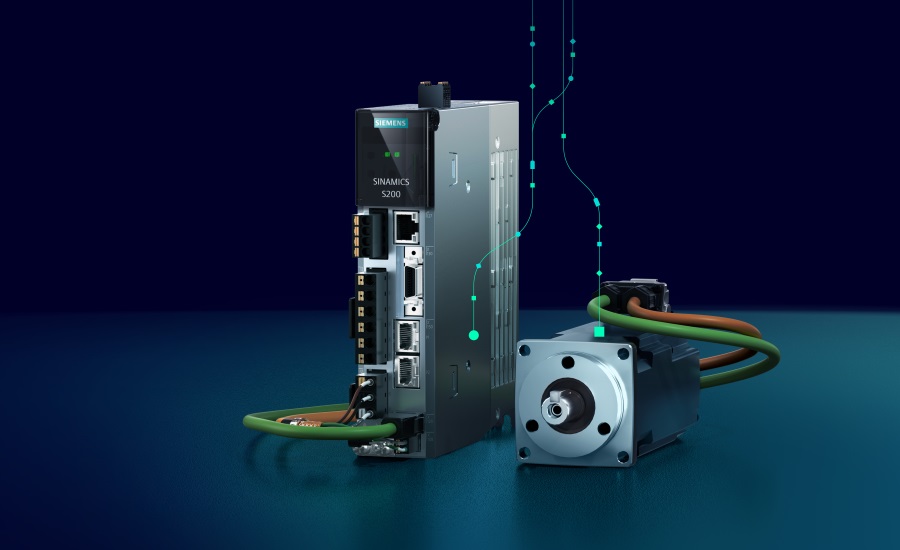 SINAMICS S200. Image courtesy of Siemens
SINAMICS S200. Image courtesy of Siemens
The SINAMICS S210 next generation servo-drive system, comprising a digitally native drive with wide range of corresponding motors and gearboxes, is designed to bring a new level of high-dynamic, motion control in mid-range operation to standalone and multi-axis machines. The company says its new servo-drive system introduces a new level of safety and security to discontinuous motion control in the mid-range segment, as well as moving, processing and positioning functions on a wide assortment of packaging, printing, labeling, pick-and-place, stacking, assembly, chip sorting and filling machines, with a special emphasis on food-and-beverage and pharmaceutical applications, owing to the availability of stainless-steel motor and planetary gearbox options.
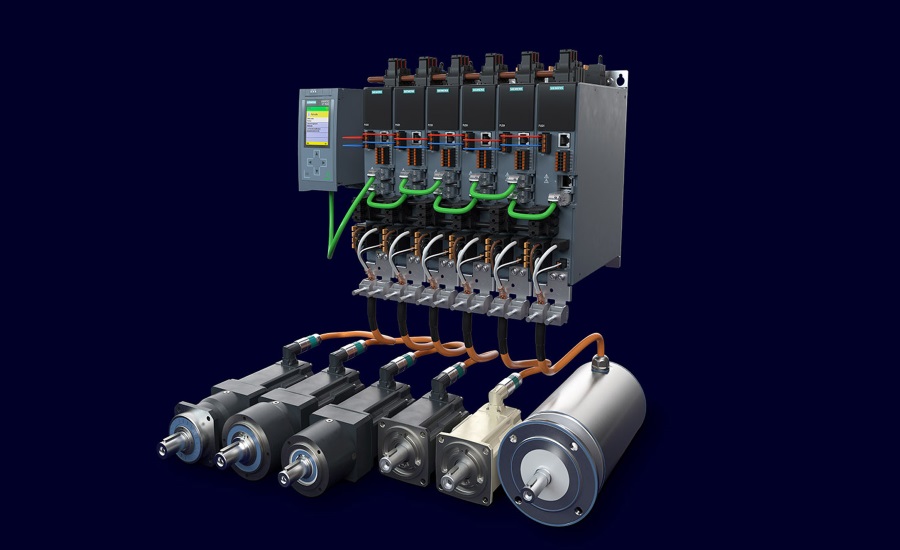 SINAMICS S210. Image courtesy of Siemens
SINAMICS S210. Image courtesy of Siemens
Siemens is expanding its offering on the SINUMERIK ONE "digital native" CNC. The company says this new control generation is now offered with innovations in software and hardware, with the goal of enabling machine builders and end-users a full digital twin of the machine tool and machining sequences. The new system software, SINUMERIK V6.20, offers new technology functions in SINUMERIK ONE designed to simplify operation, reduce machine wear and increase productivity. In the area of hardware, the new keyboards and Machine Control Panels (MCPs) are now available from 15 to 24 inches to match the design of the HMI panel with increased performance and a full HD resolution up to 1920 x 1080 pixels. The new CNCs are also integrated in the digital twin of SINUMERIK ONE (Run MyVirtual Machine), so that the appearance and operation correspond to the real control in every respect. In addition, the digital twin has been equipped with new features that simplify engineering and work preparation. And example of the updates include a 3D option that offers support for a second channel, often used for robotic integration.
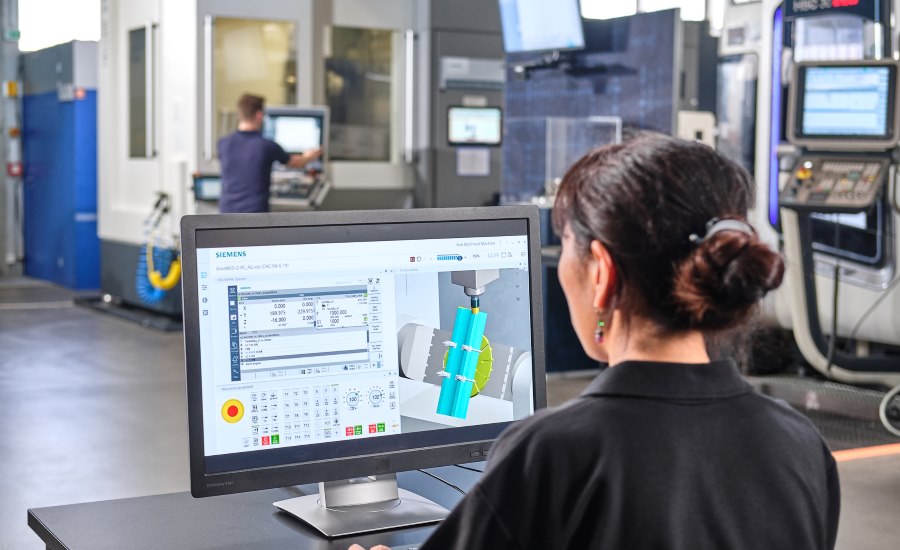
New technology functions for the SINUMERIK ONE CNC. Image courtesy of Siemens
The new Locera software platform expands the SIMATIC RFID (Radio Frequency Identification) and RTLS (Real-Time Locating System) offerings to include the digital twin of performance. Locera is a RTLS and RFID platform developed by KAASM, a technology company that specializes in providing innovative solutions for logistics and supply chain management. It is designed to help organizations track and manage their assets and inventory in real-time, providing data and insights that can be used to optimize operations, reduce costs and improve overall efficiency. The cloud-native software analyzes and visualizes dynamic data, processes events, and can be addressed directly from local MES (Manufacturing Execution System) or ERP (Enterprise Resource Planning) systems via API or webhooks. The intelligence acquired based upon position data provides the user with a comprehensive overview of asset tracking, material flow, order information or possible problem areas.
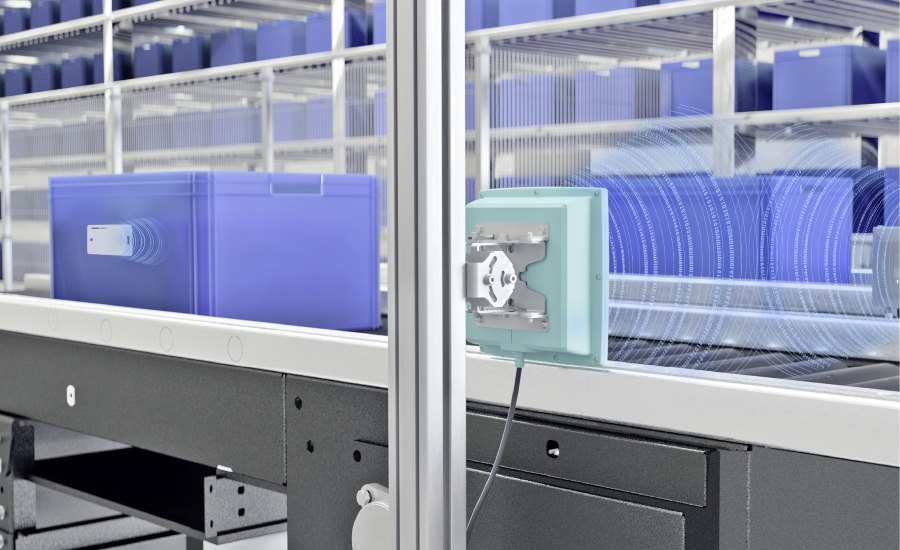
Industrial identification with RFID. Image courtesy of Siemens
The new SIMATIC S7-1500 Virtual PLC (vPLC) on Industrial Edge is an entirely virtual PLC based upon the functions and operation of the SIMATIC S7-1500 PLC and is independent of its hardware. It eExtends the current S7-1500 PLC offering, which allows for more flexible and modular design of production plants, and it has a virtual controller that is completely compatible with TIA Portal. Users can rely on familiar tools and build on projects that are already created in TIA Portal as well as use OT solutions previously employed in an IT environment and benefit from their advantages without giving up familiar structures. Users can also operate applications centrally and automate process steps in a data-centric and software-based way. The IT mechanisms are designed to allow users to optimize workflows and reduce costs.
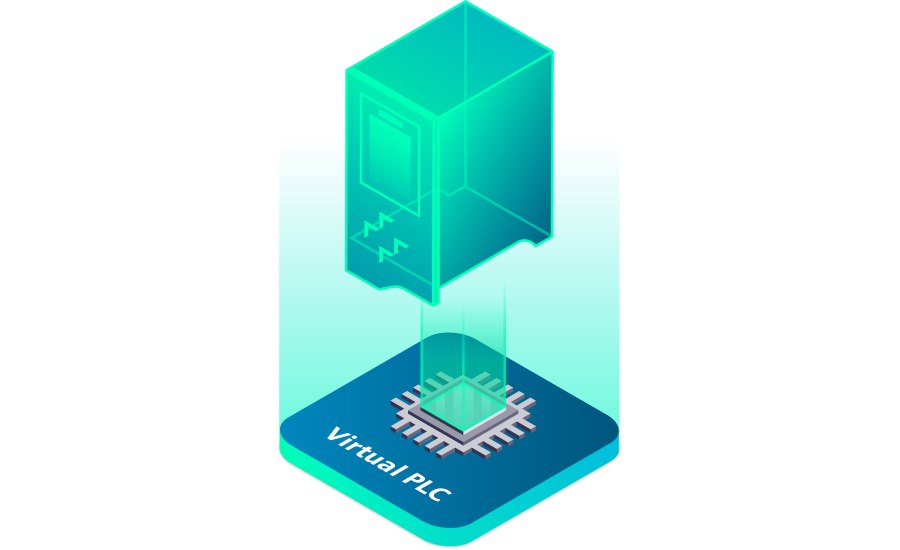
SIMATIC S7-1500 PLC. Image courtesy of Siemens
SIMATIC Robot Pick AI (robot skill) is a pre-trained, deep-learning-based vision software for advanced robotics applications like goods-to-robot order bin picking that provides out-of-the-box cognitive performance for selecting robust pick points (6-DoF grasp poses) for arbitrary "unknown" items at runtime. It is especially applicable for items in general e-commerce, e-grocery, fashion, or pharmaceutical retail. A specific, less flexible CAD model training by the user is no longer necessary (generic, model-free robot grasping). Complex use cases with arbitrary items of various shapes, sizes, and packaging can be reliably automated with a pick success rate of over 98% on the first attempt.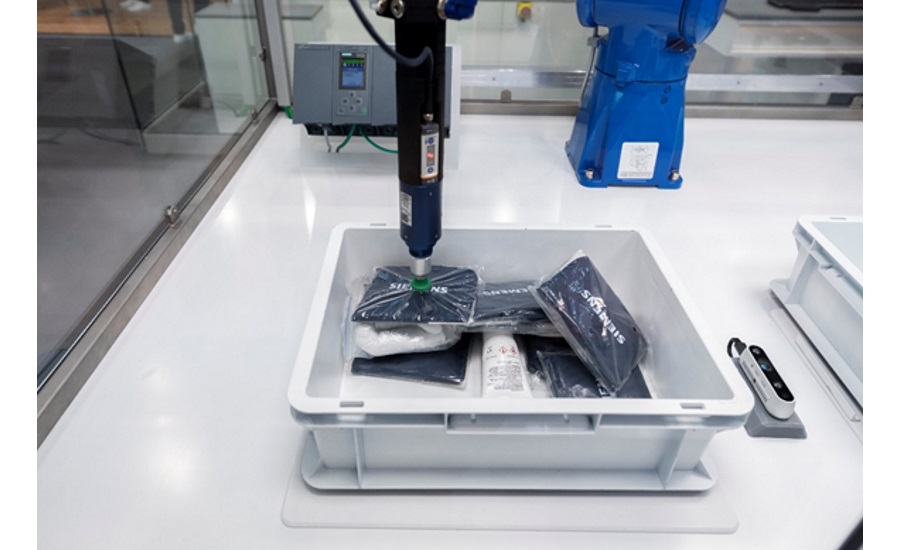
SIMATIC Robot Pick AI. Image courtesy of Siemens
SIMATIC WinCC Unified V18 is the new visualization system in the TIA Portal—from visualization up to vertical integration. Continued feature and functional improvements have been made to the WinCC Unified System software for supporting panels and runtime systems. Siemens open-source runtime platform is designed to eliminate difficult proprietary engineering obstacles and faster commissioning is possible because of pre-installed applications. This includes the ability to transfer runtime applications via various methods—such as using PC-based software, USB thumb drives, SD cards and the network.
SIMATIC WinCC Unified V18. Image courtesy of Siemens
Big Joe Introduces AMR Features & Capabilities
Big Joe Forklifts launched Pallet Mover, a user-directed autonomous mobile robot (AMR). Developed in partnership with Thoro.ai, the Big Joe Pallet Mover is an autonomous solution for floor-to-floor pallet transportation and drop-off that companies can set up and begin operating in less than one hour after receipt.
Pallet Mover AMR features that were introduced at Automate 2023 include mapping, map sharing and zone drop functionality. Dynamic mapping allows the Big Joe Pallet Mover to update onboard facility maps on the fly to keep up with changing environments and thus reduces map depreciation and the need to frequently remap areas of operation. As multiple Pallet Movers working in the same facility adapt to changes, a new map sharing feature via Wi-Fi can be used to update all units and maintain fleet performance.
In addition to enhanced mapping capabilities, the new zone drop feature allows the Pallet Mover to autonomously travel to a destination and deliver pallets to preset locations. When the zone drop feature is used, the Pallet Mover will take a load to a predefined area in a facility having multiple pallet delivery locations and will place a pallet in the first open spot based on sequential order.
According to Big Joe’s autonomous division general manager Nick Malewicki, “None of my suppliers when I was a customer of automation could deal with the high level of change in areas like receiving docks without need of hard infrastructure or an industrial engineer being regularly involved. Our focus on making this machine as easy to deploy as it is to use and where we are at with these new features is such a huge step change from where the industry has been stuck for years.”
The Big Joe Pallet Mover includes a tablet interface, LiDAR and a camera system to transport and drop pallets to locations autonomously once the operator initiates it and selects a mission. This approach uses self-driving technology as a productivity force multiplier by allowing workers to focus on higher-value tasks or direct multiple independent workflows concurrently.
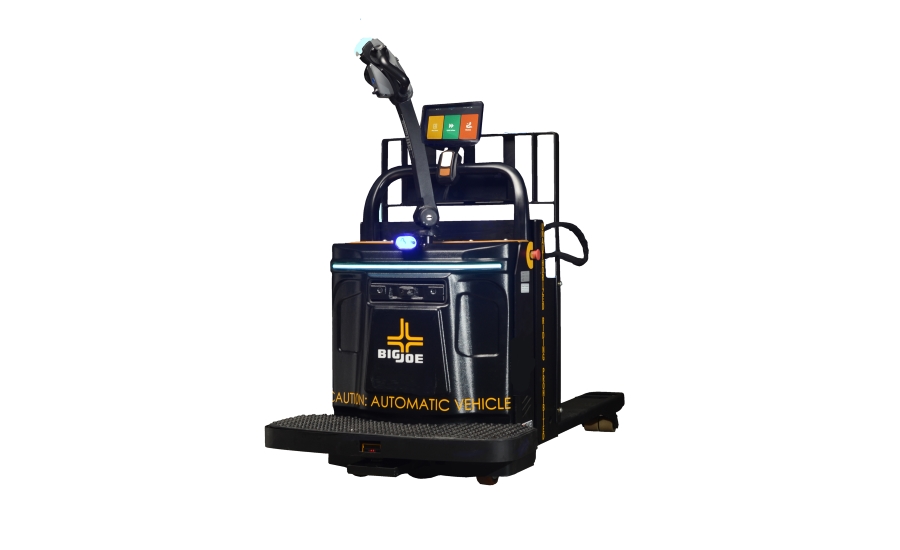
Big Joe AMR Pallet Mover. Image courtesy of Big Joe
Dobot Unveils CRA Series Collaborative Robots
Dobot launched its CRA Series collaborative robots and the CRV500 Smart Camera. The new robots incorporate harmonic drive reducers and electromagnetic brakes, alongside software with a redesigned user interface. Compared to its predecessor, the CRA Series has performance boost and is more efficient, safer and easier to use, according to the company. The CRV500 Smart Camera leverages Dobot’s 2.5D spatial compensation technology, allowing equipped robots to grab tilted or inclined objects with precision.
The CRA Series includes self-developed, integrated joints with harmonic drive reducers to improve cycle time by 25%. Its algorithm reduces vibrations, while electromagnetic brakes auto-engage in 18ms at power outage to restrict robotic arm falls less than 1mm, preventing end tools from dropping. The CRA Series also has built-in virtual boundaries, real-time payload detection and other safety features. It supports graphical programming, scripting and drag-to-teach for trajectory replay. The series works with personal computers, tablets and smartphones and more.
The control box is 25% smaller with optional IP54 protection. It can withstand harsh environments to help lower maintenance costs.
The CRA Series supports Modbus, Ethernet/IP and Profinet communication, connecting with PLC and other automation system seamlessly. With 24 I/O ports available and PNP/NPN switching, expansion is easier.
The CRV500 smart camera, with Dobot’s 2.5D spatial compensation technology, can be used with the CRA and CR Series collaborative robots to enable accurate identification of objects’ horizontal angle and inclination for accurate grabbing.
The CRV500 Smart Camera can be set up using the DOBOT collaborative robot control software without further development for easy and quick deployment.
The CRA Series released has seven robot models with 3kg, 5kg, 7kg, 10kg, 12kg, 16kg and 20kg payloads and a working radius from 620mm to 1,700mm, covering various industries including consumer electronics, semiconductor, automotive, renewable energy, metal processing, logistics, healthcare, retail and more. It is also capable of other applications such as pick and place, sorting, screwdriving, inspection, gluing, welding, transportation, polishing and palletizing.
Dobot has developed process packages software to simplify automation deployment of complex processes including screwdriving, welding and palletizing. With this software, users can set up the automation processes without writing code.
The 3kg, 5kg and 10kg payload models in the CRA Series are compatible with the DOBOT SafeSkin. The SafeSkin non-contact pre-collision detection solution can sense obstacles coming within 15cm and stop before colliding.
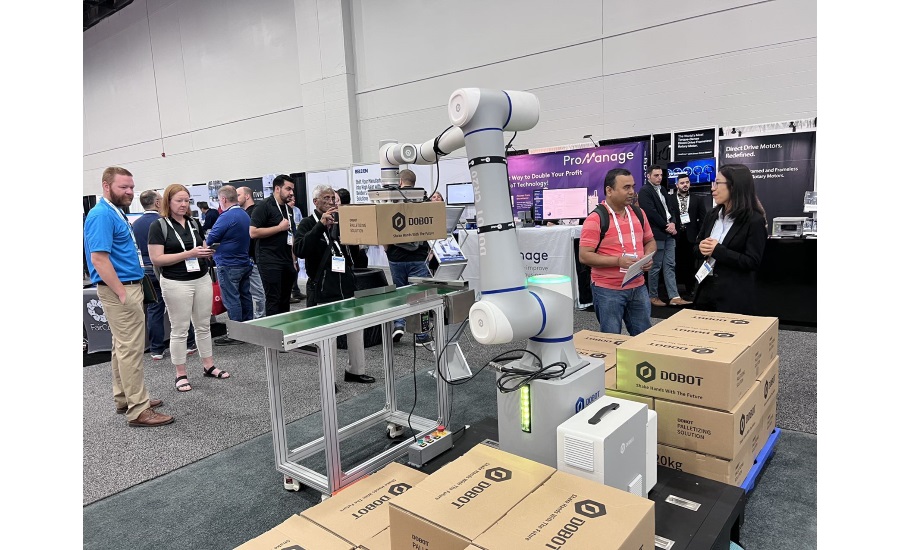
Dobot CRA Series collaborative robot. Image courtesy of Dobot
Gather AI Drones Automate Inventory Monitoring
Gather AI is using drones to automate inventory monitoring processes for warehouse operators to decrease the cost of inventory, improve productivity and boost revenue.
With Gather AI’s solution, inventory drones can fly through a warehouse, photograph pallet locations, and then compare the bar codes, text and images with the warehouse management system (WMS).
According to customer data, the solution is 15 times faster than traditional cycle-counting processes, and the customer can decrease the WMS error rate by 72% in three months.
The Gather AI solution dashboard helps warehouse teams find and fix inventory exceptions. They can review a list of exceptions on their dashboard, scroll through each one, view the picture of the pallet location and determine what needs to happen next, including fixing the information in their WMS. This can be done at a desk instead of walking through the warehouse.
The improved “Search by Inventory Attribute” dashboard function allows users to search for inventory details, including by lot code. When searching by lot code, users can find the locations where the product is stored, view images of the product at these locations and ensure the product is available for the manufacturing line. With this functionality, users can avoid a line shut down. This capability also helps manufacturing warehouse managers avoid waste across inventory, overproduction and skill underutilization. By leveraging the drones, warehouse employees can handle more value-added activities like researching variances, auditing and training to support operations. They can also take action from their desks to resolve any inventory errors before they cause a line to go down.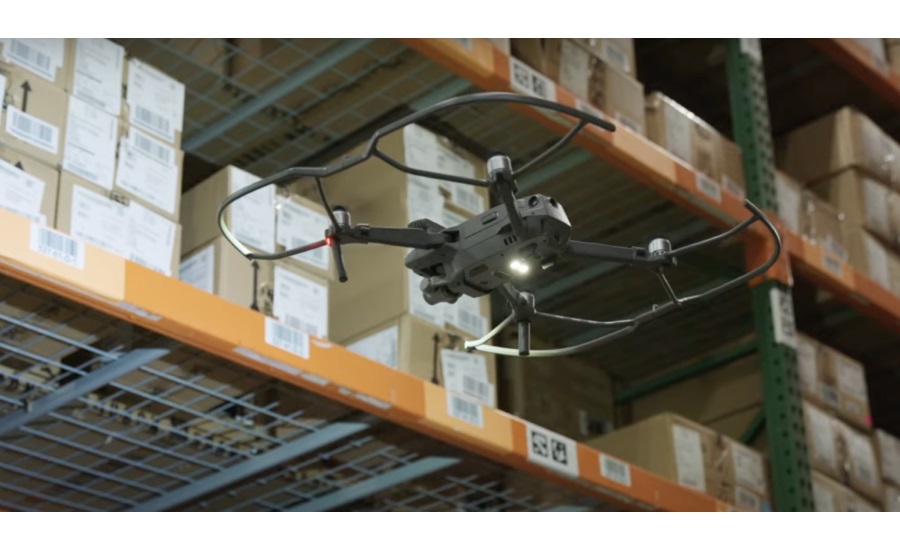
Gather AI's drone-powered inventory monitoring solution. Image courtesy of Gather AI
IndustrialNext Unveils Modular Workstations
IndustrialNext unveiled its modular workstations to the public. The workstations will leverage AI and data analytics with the goal of driving efficiencies across production.
Lukas Pankau, CEO of IndustrialNext, indicated that while many in the industry seek to adopt advanced processes, most manufacturers do not have an accessible way to make the transition. The modular workstations not only utilize AI to provide value, but offer the flexibility to scale as the system continuously learns where to drive improvements.
Measuring 3.5 ft. x 2.9 ft. x 7 ft., the modular stations aim to bring a holistic approach to analysis and learning to the factory floor. Serving as a decentralized hub, the AI integration has the ability to control automation equipment attached to the workstations and use collected data to maximize the line’s process engineering.
"Most workstations on the market today tend to be very simple and makeshift or customized, thereby making them extremely expensive,” Pankau says. IndustrialNext’s modular workstations aim to merge these two approaches by providing a system that can be quickly repurposed based on needs and adapted to new configurations.
These workstations were designed for flexibility and can reportedly be disassembled and reconfigured in under 60 seconds. The AI software integration unlocks the potential of the workstations by providing live, analytical feedback to make process improvements and create efficiencies in real time.
IPLUSMOBOT Showcases Intelligent Mobile Robot Products
IPLUSMOBOT unveiled its series of intelligent mobile robot products and solutions designed for smart manufacturing factories.
The EMMA series offers a standard mobile robot platform that can be equipped with different attachments, such as collaborative arms, rollers and lifting module. This enables seamless automation of material transfer and loading/unloading between different production processes. The EMMA 400L has a compact design and is capable of carrying a payload of 400kg. It can navigate passages as narrow as 70cm, meeting the requirements of load capacity and space for internal logistics.
The FOLA series consists of forklifts for intra-logistics automation and warehouse automation. These autonomous forklifts can be utilized for pallet handling, stacking and lifting. The FOLA-DN1416 is a pallet stacker forklift with load capacity of 1400kg and lifting height of 1600mm. In practical operations, the DN1416 utilizes environmental perception and visual detection to stack palletized materials. The IPLUSMOBOT fleet management provides flexible scheduling and path planning for multiple vehicles, various scenarios and multiple functions.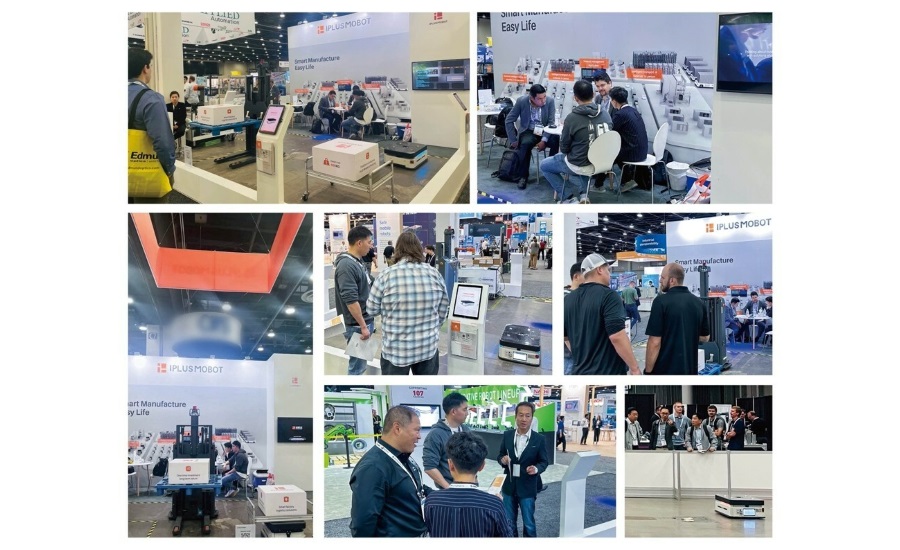
IPLUSMOBOT unveiled its series of intelligent mobile robot products and solutions. Images courtesy of IPLUSMOBOT
SCHNEEBERGER Showcases Linear Motion Solutions
SCHNEEBERGER launched its linear positioning and motion systems. The systems on display included SCHNEEBERGER MINIRAIL miniature guideways, MONORAIL AMS distance measuring system, gear racks, linear and linear roller guideways, SLA Actuators and mineral cast machine foundations, among other lines.
SCHNEEBERGER systems and solutions enable OEMs to accelerate their design and manufacturing, reduce assembly time and labor and achieve a lower total cost of ownership.
MINIRAIL miniature guideways are designed for medical equipment, additive manufacturing and other applications when space is at a premium and where high acceleration and/or extreme load values are involved.
Integrated MONORAIL AMS measuring head and scale for MONORAIL profiled linear guideways makes precision distance measurement possible. MONORAIL AMS solutions are machine-compatible and ready to install to reduce the lifetime costs of mechanical engineering and automation applications.
MONORAIL BM profiled linear guideways (with balls) deliver precision and increased service life with minimal maintenance. All carriages feature longitudinal cross wipers to seal against dirt and debris.
MONORAIL MR profiled linear roller guideways with static load carrying capacity to achieve higher machining rates and enhanced geometrical accuracy and surface quality for workpieces, and improved vibration behavior and smaller vibration amplitudes for extended tool life.
Gear racks enable linear movements and can be used in large machines and systems as a solution when machine components with large axial forces require long linear movement with consistent stiffness over the rack length.
Super-compact SLA Actuator offers linear positioning and uses recirculating ball linear guides, which provide smooth motion and high load capacity. A ball screw version is available for higher speeds and duty cycles. Various leads are available for the lead screw and ball screw versions.
Mineral Cast machine foundations are the carbon-reducing, environmentally sustainable organic solution to achieve vibration damping for automated machinery operation while promoting OEM ESG goals. Applications include metal grinding machines and manufacturing machinery for the solar, electronics, packaging and medical device industries.
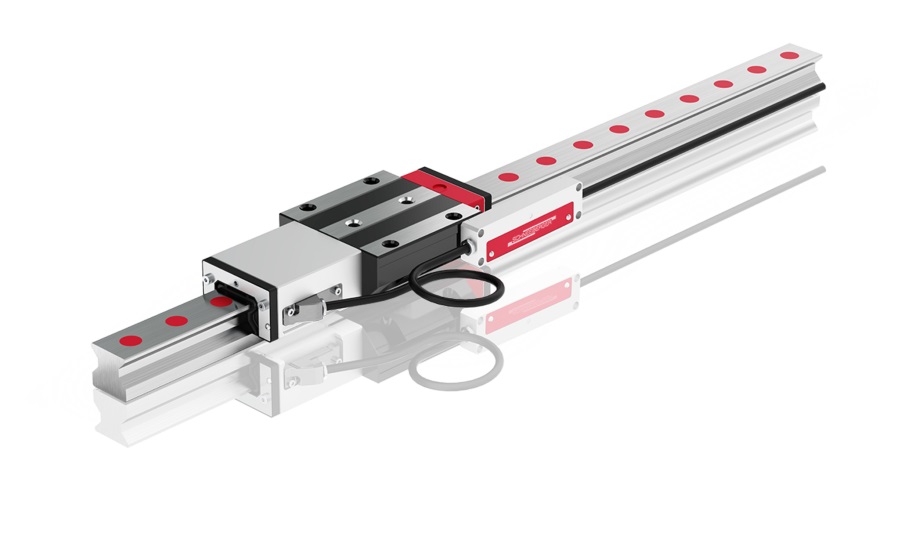
SCHEENBERGER MONORAIL AMS. Image courtesy of SHEENBERGER
Looking for a reprint of this article?
From high-res PDFs to custom plaques, order your copy today!



-linmot-usa-robotic-linear-motion-solutions-pack-expo.webp?height=200&t=1691686341&width=200)
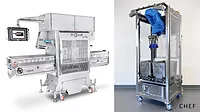
-8036-23-FST_Composing_Drehende_Wellen.webp?height=200&t=1694615824&width=200)
